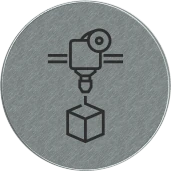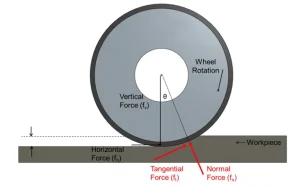
PRECISION GRINDING
Steel Lavorazioni Meccaniche has gained a great deal of experience in most machining operations, including tangential grinding.
The technical excellence of Steel Lavorazioni Meccaniche
Precision grinding is a critical process for achieving exceptionally smooth and accurate surfaces, essential in industries that demand high-quality mechanical components.
With 30 years of experience, Steel Lavorazioni Meccaniche provides a comprehensive service, integrating precision grinding with turning, milling, and EDM machining to ensure flawless results. Precision down to the micrometer is crucial, as even the smallest imperfection can compromise machine performance. Our multi-industry expertise, combined with cutting-edge technology, guarantees reliability, superior quality, and competitive lead times in every project. We ensure fully traceable and certified processes, meeting the most rigorous industrial standards.
PRECISION GRINDING: A SPECIALIZED FORM OF MECHANICAL GRINDING
Before discussing surface grinding, it is essential to define the grinding process itself.
Grinding is a precision machining technique designed to achieve extremely smooth surfaces with minimal roughness and tight geometric and dimensional tolerances. Among all machining processes, grinding delivers the highest level of accuracy and finish quality.
Since grinding is a finishing operation, it is performed at the end of the production cycle. Additionally, due to its high cost, it is only applied where an exceptional level of surface finish is required.
There are various types of grinding, and precision surface grinding (or tangential grinding) is specifically used to flatten surfaces by removing even the most imperceptible excess material.
SURFACE GRINDING: KEY FACTORS FOR SUCCESS
Two primary factors determine the success of precision grinding:
Unlike milling machines, the spindles in surface grinding machines must maintain extremely precise rotational accuracy to ensure a perfectly flat surface. To guarantee high precision, grinding machines must be free from vibrations, as even the slightest instability can compromise accuracy.
Modern CNC grinding machines enable the creation of various profiles, thanks to precise motion control and the ability to shape the grinding wheel to follow custom profiles. However, the operator must still possess extensive knowledge to correctly use these advanced machines.
TYPES OF PRECISION GRINDING
As mentioned earlier, there are various types of grinding, which differ based on: the type of machine used, the surfaces being machined and the grinding direction. Below is an overview of the different grinding processes:
Cylindrical grinding is performed with the grinding wheel’s axis parallel to the workpiece’s rotation axis. This method is used to machine cylindrical or conical parts, both internally and externally.
Similar to cylindrical grinding, plunge grinding also involves a grinding wheel parallel to the workpiece’s axis. This method is mainly used for machining cylindrical or conical surfaces and shoulders.
Surface grinding operates with the grinding wheel’s rotation axis perpendicular to the movement of the worktable. It produces flat surfaces with high precision and superior surface finish.
Centerless grinding achieves high precision on small cylindrical parts and components with variable revolution geometries, eliminating the need for centers or fixtures.
Vertical grinding is similar to surface grinding, but the grinding wheel moves vertically. This allows for machining of complex profiles with greater flexibility.
Electrochemical grinding is a unique process in which material removal occurs through an electrolytic reaction, rather than traditional abrasive cutting.
SURFACE GRINDING IN DETAIL
Surface grinding is an extremely precise machining process used to achieve low surface roughness. It involves removing excess material in tiny chips using a grinding wheel. This is the only machining process that can be performed even after surface hardening heat treatments.
The machine used for surface grinding is among the simplest and most common. It consists of a spindle and a worktable. The spindle moves along the Z-axis, the worktable moves along the X-axis, the workpiece moves along the Y-axis via a hydraulic circuit.
At each stroke, the grinding wheel is lowered by a set increment to continue the machining process.

In this operation, the abrasion is performed by the grinding wheel. The workpiece moves back and forth along the machine table, allowing it to be ground precisely. Often, after grinding one surface, the workpiece is rotated to grind the opposite face, ensuring perfect parallelism between the two surfaces.

KEY PARAMETERS OF SURFACE GRINDING
As with other precision machining processes, surface grinding requires specific machining parameters, which vary depending on the material and type of grinding operation.
Chosen based on the material type and machining requirements. Cutting speed is determined by the spindle speed and the grinding wheel diameter and is measured in m/s.
Dependent on the material, grinding method, and type of grinding wheel. For surface grinding, transverse feed rates typically range between 2/3 and 2/10 of the grinding wheel thickness.
Determined by the material, machining type, and grinding wheel. Surface grinding confirms extreme precision, with depths of cut typically not exceeding 0.2 mm, and in many cases, reaching only 0.001 mm.
IN WHICH INDUSTRIES IS PRECISION GRINDING APPLIED?
The precision grinding process is fundamental and is used across a vast range of industries—especially those requiring extremely smooth surface finishes, primarily in mechanical engineering.
For example, precision grinding is essential for mechanical components such as: Molds, Measuring instruments, Crankshafts, Aerospace components, Bearings, Guides and more
Often, surface grinding is a complementary process to turning, milling, and electrical discharge machining (EDM).
Even the slightest imperfection can compromise machine performance, making micron-level precision crucial for this process.
b
WHY CHOOSE STEEL LAVORAZIONI MECCANICHE FOR PRECISION GRINDING?
For over 30 years, Steel Lavorazioni Meccaniche has provided its customers with cutting-edge expertise and advanced technology to manufacture high-precision mechanical components through specialized machining processes.
The company offers a comprehensive service, built on extensive experience in precision grinding and mechanical machining.
Its diverse client portfolio has allowed the company to develop a multi-industry approach, gaining solid expertise in processing a wide variety of materials and building strong capabilities in producing high-performance components.
Steel Lavorazioni Meccaniche serves key industries such as aerospace, food processing, automation, packaging, recycling, and nuclear energy, ensuring:
The company is certified to meet the stringent standards required by the aerospace, military, and nuclear industries, guaranteeing top-tier quality and reliability.
All of this makes Steel Lavorazioni Meccaniche a leading company in the industry and the ideal partner for any industrial business in need of specialized precision grinding services
